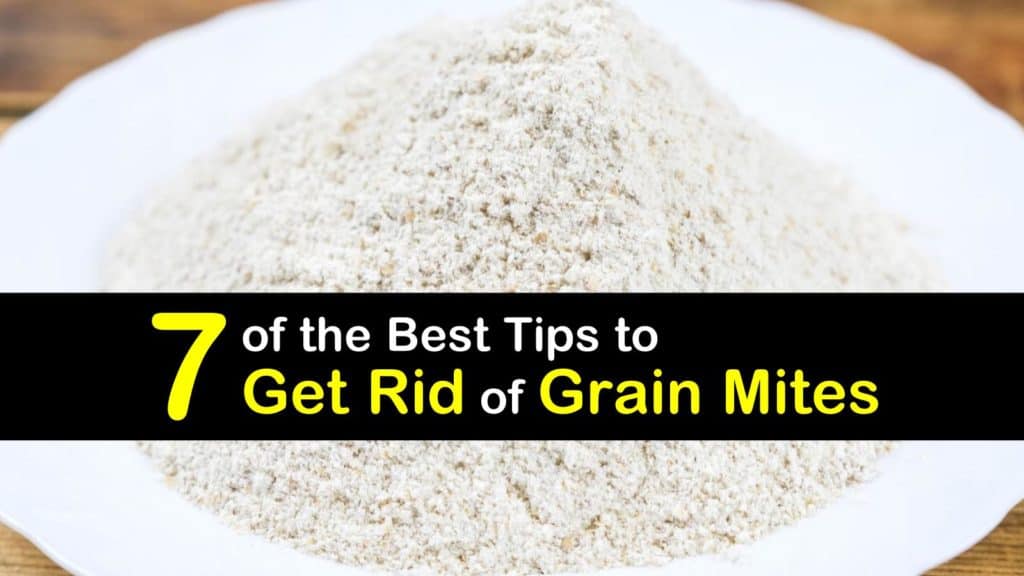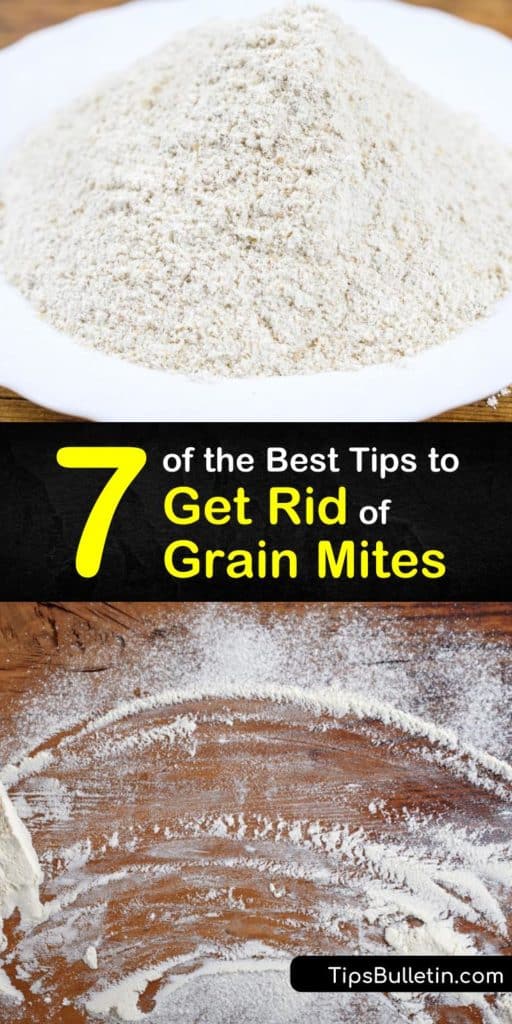How to Get Rid of Grain Mites in Kitchen
Grain mites are tiny pantry pests that infest dry food stocks like flour, cereals, rice, dried fruit, and pet food. Read on to discover the best tips and tricks for how to get rid of grain mites.
While it's alarming to find bugs in flour or other food, it probably isn't a reflection of your kitchen's tidiness. These pests generally hitch a ride into your pantry on purchased food packaging.
Grain mites are more common in bulk storage and agricultural settings, but they sometimes occur in home kitchens and pantries, too. Also known as flour mites, Acarus siro are small white insects that occasionally infest food storage areas.
They tend to thrive in dark, warm, humid conditions. In this article, you'll find out where grain mites come from, how to know if you have an infestation, and how to eliminate the problem and prevent them from returning.

- How to Identify a Grain Mite Infestation
- How to Get Rid of Grain Mites
- DIY Recipes for Getting Rid of Flour Mites
- How to Get Rid of Grain Mites with Hot Soapy Water
- Get Rid of Grain Mites with High Temperatures
- Kill Grain Mites with Bleach
- Kill Grain Mites with Vinegar
- Get Rid of Grain Mites with Essential Oils
- Kill Grain Mites with Diatomaceous Earth
- How to Prevent a Grain Mite Infestation
- Where Do Grain Mites Come from?
- Are Grain Mites a Health Risk?
How to Identify a Grain Mite Infestation
Grain mites are difficult to see with the naked eye. Use a magnifying glass for identification. Here are some methods of determining whether you are dealing with a grain mite infestation.
The first sign is typically brown, dust-like residue that the mites leave behind. If you suspect a mite problem, try rubbing the mite dust between your fingers to check for the minty odor that crushed flour mites emit.
The infested food might also develop a sickly sweet smell or taste. If you suspect you might have grain mites, spread some of the potentially infested food out in a thin layer and check it for movement after 15 minutes.
Alternatively, place a piece of double-sided tape in the food storage area or on packaging. The mites stick to the tape as they move.
Are you unusually itchy after handling flour or other grains? Flour mites don't bite or sting, but some people have an allergic reaction to the mite dust, sometimes called "grocer itch."
In addition to grain mites, several other types of mites affect food storage areas. The main culprits are cheese mites, which feed on cheese, and mold mites, which feed on a fungus in continually damp areas.
Grain mites are distinguished from other types of mites by their food source. They're sometimes confused with weevils, which are larger and darker colored, and grain beetles, which are also darker and roughly the same size as grain mites.
However, getting rid of weevils and grain beetles is often accomplished the same way.
How to Get Rid of Grain Mites
A grain mite infestation is possible even in the cleanest kitchens under the right conditions. However, getting rid of flour mites is usually relatively simple. Here's what to do to eliminate an infestation and keep them from re-entering your pantry.
tb1234
Preparing Your Kitchen for Treatment
- Closely inspect all the dry food products in your kitchen cupboards, pantry shelves, and any other food storage areas for signs of mite dust or activity.
- Discard all infested food items in a sealed plastic bag in an outdoor garbage container.
- Move all uninfested food to a different location.
- Vacuum affected areas, making sure to reach all cracks and crevices where mites could be hiding. Throw away the vacuum contents in an outdoor garbage container.
tb1234
DIY Recipes for Getting Rid of Flour Mites
It's best not to use pesticides to kill grain bugs, as the chemicals could have harmful effects on your food. Instead, consider trying one of our DIY recipes for getting rid of flour mites in your home safely.
How to Get Rid of Grain Mites with Hot Soapy Water
The first step in how to get rid of grain mites is washing out your kitchen cupboards, pantry shelves, and any canisters that contained contaminated food with hot soapy water.
Hot water kills grain mites and their eggs on contact. Be sure to regularly rinse your cleaning rag or sponge to avoid unintentionally transporting the mites around your kitchen.
Get Rid of Grain Mites with High Temperatures
Dry out your pantry and kitchen cupboards with a hairdryer. Grain mites thrive in humid conditions, so you need to ensure that you completely dry your food storage area after washing it. The hot air from a hairdryer kills the remaining grain mites.
Kill Grain Mites with Bleach
Make a diluted bleach solution to kill grain mites on contact. When using bleach, wear gloves, and avoid contact with your skin or eyes.
Ensure that the area is well-ventilated so that you're not breathing the fumes. Consider opening a window when mixing and spraying the bleach solution and wearing safety goggles and a mask.
tb1234
Bleach Solution
- 1 cup hot water
- ½ cup bleach
tb1234
Mix one part bleach with two parts hot water in a clean spray bottle. Thoroughly spray all surfaces inside the food storage areas and wipe down with a clean rag or paper towels.
Kill Grain Mites with Vinegar
Use a DIY vinegar spray for getting rid of flour mites and their larvae and eggs. The acetic acid in vinegar, and one of the benefits of white distilled vinegar, is that it burns mites on contact and acts as a repellent.
tb1234
Vinegar Spray
- 1 cup hot water
- 1 cup white vinegar
tb1234
Combine equal parts vinegar and hot water in a clean spray bottle. Thoroughly spray all surfaces inside the food storage areas and wipe down with a clean rag or paper towels. As an added bonus, vinegar is an excellent natural pantry moth repellent, as well.
Get Rid of Grain Mites with Essential Oils
Some essential oils have insecticidal properties that kill grain mites and other household pests. Neem, tea tree, orange, and eucalyptus oils are all effective.
tb1234
Essential Oil Insect Spray
- 1 cup hot water
- 1 teaspoon essential oil (neem, tea tree, orange, or eucalyptus)
tb1234
Mix the essential oil with hot water in a clean spray bottle. Thoroughly spray all surfaces inside the food storage areas and wipe down with a clean rag or paper towels.
Kill Grain Mites with Diatomaceous Earth
One of the excellent effects of Diatomaceous Earth is its bug killing properties. Use food grade Diatomaceous Earth for getting rid of flour mites.
Diatomaceous Earth is a white powder containing silica, which kills grain mites by coating their bodies as they walk through it and wearing away their protective outer coating.
Spread the Diatomaceous Earth over the surfaces of your food storage area, making sure to cover the crevices. Wear a respirator mask to avoid inhaling the dust.
How to Prevent a Grain Mite Infestation
Prevention is the best form of household pest control. Keeping your pantry dry and well-lit is an essential part of how to get rid of grain mites and keep them from re-infesting an area. Here are some tips for preventing a grain mite infestation.
tb1234
Grain Mite Prevention
- Keep your dry food in airtight containers. If you eliminate the food source, any remaining grain mites eventually die.
- Do not combine old food with newly purchased items.
- Wash all sealed containers in hot soapy water between uses. Make sure they're completely dry before refilling.
- Ensure that your food storage area is well ventilated. If you live in a particularly humid area, consider installing a dehumidifier.
- Bay leaves are effective at repelling grain mites. Place a bay leaf inside canisters with your dry food, or tape it to the lid.
- Keep pet food in sealed containers, and wash them with hot soapy water between uses. Grain mites are especially problematic for reptile owners with mealworm farms.
tb1234
Where Do Grain Mites Come from?
Grain mites typically enter your kitchen in food products or packaging. Although it's a less common way of infestation, grain mites can attach to other insects or animals during a juvenile period of their life cycle called hypopus.
The mites hide in crevices, so make sure to be extremely thorough with your initial cleaning, and keep checking for at least two months.
Grain mites have a life cycle of roughly 28 days, and a female lays up to 20-30 eggs daily, so an infestation spreads quickly. The eggs and hypopus juveniles are more resistant to insecticide than adults and larvae, which may account for an infestation resurgence.
Are Grain Mites a Health Risk?
Although grain mites themselves are not harmful to human health, there are other risks associated with a mite infestation. The mites sometimes transport mold spores and other toxins.
Some people may also have an inflammatory allergic reaction after eating the contaminated food. Discard any infested food products immediately.
Because a grain mite infestation spreads quickly, it is crucial to act immediately. Finding bugs in flour or other food is distressing, but by following our tips for how to get rid of grain mites, you know how to quickly take care of the problem.
Understanding where grain mites come from and what their ideal conditions are equips you to prevent any future infestation.

If you found this information valuable about ways to kill grain mites and prevent an infestation, please share this article about how to get rid of grain mites on Facebook and Pinterest with your family and friends.
How to Get Rid of Grain Mites in Kitchen
Source: https://www.tipsbulletin.com/how-to-get-rid-of-grain-mites/